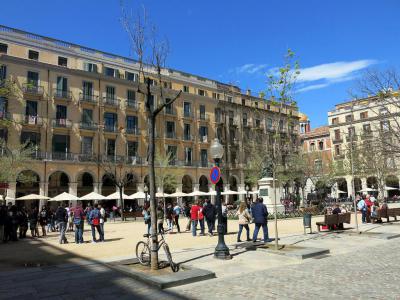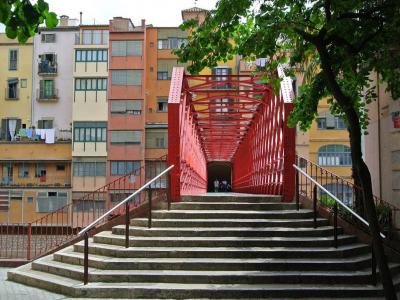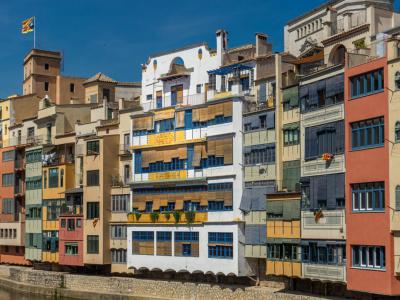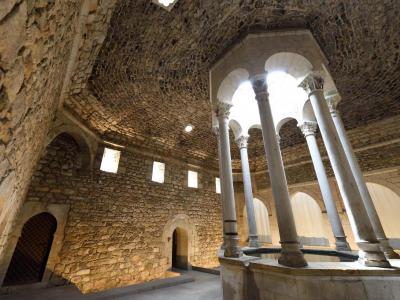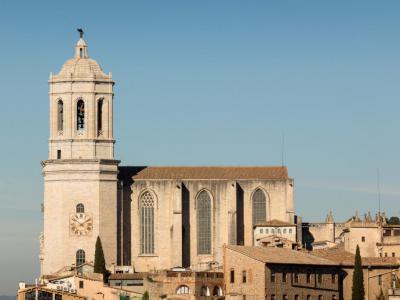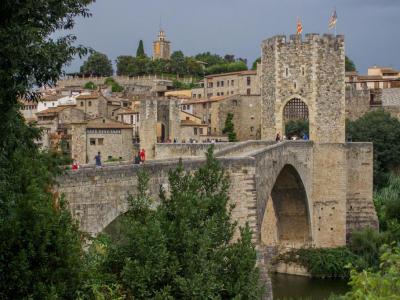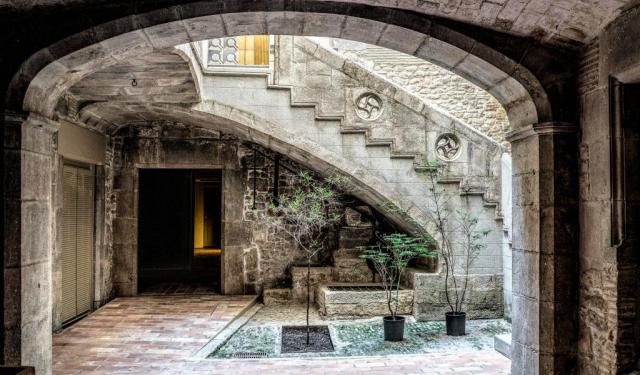
Girona Introduction Walking Tour (Self Guided), Girona
The beautiful city of Girona is located in the northeastern part of Catalonia, Spain. The area was first settled by ancient Iberians that inhabited the region of the Iberian Peninsula as early as the 6th century B.C. The Romans later occupied the town, where they built a citadel and gave the city its original name of "Gerunda."
Girona is situated at the junction of several rivers. The Onyar River and the Ter River form the main arteries across the city. The Onyar divides the medieval Old City from the more modern area of Girona. Several bridges cross the river. One is the Eiffel Bridge, a unique iron structure painted red. It was built by the engineer best known for his work on the Eiffel Tower.
A defensive fortification was built during Roman times, then rebuilt in the 14th century on the foundations of the ancient Roman wall. The ancient city walls surround the medieval old town of Girona. For hundreds of years, this city wall protected Girona against enemy sieges. Visitors can walk along the top of the walls and climb up one of the watch towers to see spectacular views.
A must-see historical landmark in Girona is the magnificent Girona Cathedral. The wide, high stairway that leads up to the entranceway into this monumental stone structure is quite impressive. The cathedral's tall bell tower is a prominent feature of Girona's skyline. Nearby is another historical church, the Church of St. Felix. This church features a Gothic spire, another eye-catching part of the skyline.
One of Europe's best-preserved Jewish Quarters is in Girona. Situated in the heart of the Old City, Girona's Jewish Quarter dates from the 12th century. It thrived until 1492, when Jewish people who would not convert to Catholicism were expelled from Spain. Don't miss a visit to the Jewish History Museum to learn more about the background, culture, and heritage of the medieval Jewish community of Girona.
Girona is a picturesque and charming city you'll love exploring on this self-guided walking tour.
Girona is situated at the junction of several rivers. The Onyar River and the Ter River form the main arteries across the city. The Onyar divides the medieval Old City from the more modern area of Girona. Several bridges cross the river. One is the Eiffel Bridge, a unique iron structure painted red. It was built by the engineer best known for his work on the Eiffel Tower.
A defensive fortification was built during Roman times, then rebuilt in the 14th century on the foundations of the ancient Roman wall. The ancient city walls surround the medieval old town of Girona. For hundreds of years, this city wall protected Girona against enemy sieges. Visitors can walk along the top of the walls and climb up one of the watch towers to see spectacular views.
A must-see historical landmark in Girona is the magnificent Girona Cathedral. The wide, high stairway that leads up to the entranceway into this monumental stone structure is quite impressive. The cathedral's tall bell tower is a prominent feature of Girona's skyline. Nearby is another historical church, the Church of St. Felix. This church features a Gothic spire, another eye-catching part of the skyline.
One of Europe's best-preserved Jewish Quarters is in Girona. Situated in the heart of the Old City, Girona's Jewish Quarter dates from the 12th century. It thrived until 1492, when Jewish people who would not convert to Catholicism were expelled from Spain. Don't miss a visit to the Jewish History Museum to learn more about the background, culture, and heritage of the medieval Jewish community of Girona.
Girona is a picturesque and charming city you'll love exploring on this self-guided walking tour.
How it works: Download the app "GPSmyCity: Walks in 1K+ Cities" from Apple App Store or Google Play Store to your mobile phone or tablet. The app turns your mobile device into a personal tour guide and its built-in GPS navigation functions guide you from one tour stop to next. The app works offline, so no data plan is needed when traveling abroad.
Girona Introduction Walking Tour Map
Guide Name: Girona Introduction Walking Tour
Guide Location: Spain » Girona (See other walking tours in Girona)
Guide Type: Self-guided Walking Tour (Sightseeing)
# of Attractions: 11
Tour Duration: 1 Hour(s)
Travel Distance: 1.7 Km or 1.1 Miles
Author: nataly
Sight(s) Featured in This Guide:
Guide Location: Spain » Girona (See other walking tours in Girona)
Guide Type: Self-guided Walking Tour (Sightseeing)
# of Attractions: 11
Tour Duration: 1 Hour(s)
Travel Distance: 1.7 Km or 1.1 Miles
Author: nataly
Sight(s) Featured in This Guide:
- Plaza de la Independencia (Independence Square)
- Pont de les Peixateries Velles (Eiffel Bridge)
- Rambla de la Libertad (Freedom Boulevard)
- Onyar River Colored Houses
- Jewish Quarter and Jewish History Museum
- Casa Maso (Maso House)
- Basilica de Sant Feliu (Church of St. Felix)
- Museo de Arqueologia de Cataluna (Archaeology Museum of Catalonia)
- Banos Arabes (Arab Baths)
- Catedral de Girona (Girona Cathedral)
- Passeig De La Muralla (Ancient City Walls)
1) Plaza de la Independencia (Independence Square)
In the heart of Girona, near the left bank of the Onyar River and just steps from the Sant Agusti Bridge (Pont de Sant Agusti), is the Independence Square (Plaza de la Independencia). This large rectangular square is a lively place filled with restaurants, bars, and shops occupying the bottom floors of the neoclassical buildings. Independence Square is located at the spot once occupied by the Convent of Sant Agustí de Girona.
In the center of the square is the "Monument to the Defenders of Girona," honoring those who defended the city against sieges by the French in 1808 and 1809. Prominently placed on a stone pedestal, this dramatic statue of three men in battle was created in 1894 by Catalan sculptor Antoni Perera. Look for "The Turtle Boy" ("El Nen de la Tortuga"), a sculptural fountain of a boy sitting on a turtle at the north end of the square.
Independence Square offers a picturesque setting for taking a stroll or enjoying a meal at one of the area's restaurants. Lovely arched colonnades and small balconies at every window enhance the five-story buildings surrounding the square. Benches and trees line the central plaza. There is also lots of outdoor dining available at the various cafes.
In the center of the square is the "Monument to the Defenders of Girona," honoring those who defended the city against sieges by the French in 1808 and 1809. Prominently placed on a stone pedestal, this dramatic statue of three men in battle was created in 1894 by Catalan sculptor Antoni Perera. Look for "The Turtle Boy" ("El Nen de la Tortuga"), a sculptural fountain of a boy sitting on a turtle at the north end of the square.
Independence Square offers a picturesque setting for taking a stroll or enjoying a meal at one of the area's restaurants. Lovely arched colonnades and small balconies at every window enhance the five-story buildings surrounding the square. Benches and trees line the central plaza. There is also lots of outdoor dining available at the various cafes.
2) Pont de les Peixateries Velles (Eiffel Bridge) (must see)
Spanning across the Onyar River is one of Girona's most famous bridges, the Bridge of the Old Fishmongers (Pont de les Peixateries Velles) — sometimes called the Bridge of Red Levers (Palanques Vermelles Bridge). It is more commonly referred to as the Eiffel Bridge after the engineer that designed and built it, Gustave Eiffel. Eiffel is most well-known for his important work on the Eiffel Tower, an iconic landmark in Paris, France.
The construction of the Eiffel Bridge took place in 1877. The iron bridge is distinguished by its latticework design that forms an ornate grid-like framework over the top and sides of the bridge. It is painted in a deep brick-red color that is eye-catching. The bridge's width is less than nine feet, and its length across the river is about 136 feet. The floor of the bridge is paved with wooden planks to prevent rusting.
Crossing over this narrow footbridge offers fabulous river views. The picturesque, brightly-colored houses that line the Onyar River are charming. Across the bridge, near the right bank of the river, you'll find the bustling Rambla of Freedom (Rambla de la Llibertat). It is a popular pedestrian-only street that offers shopping and dining in the old town area. On the left bank is the more modern section of Girona, where a stroll up Santa Clara Street (Carrer de Santa Clara) will take you to Girona's lively Independence Square.
The Eiffel Bridge is an impressive structure that is a must-see on your tour around Girona. Head up the steps at either end of the bridge and stroll across it. You'll want to stop along the way to look at the view — and take advantage of the great photo opportunities while you're there!
The construction of the Eiffel Bridge took place in 1877. The iron bridge is distinguished by its latticework design that forms an ornate grid-like framework over the top and sides of the bridge. It is painted in a deep brick-red color that is eye-catching. The bridge's width is less than nine feet, and its length across the river is about 136 feet. The floor of the bridge is paved with wooden planks to prevent rusting.
Crossing over this narrow footbridge offers fabulous river views. The picturesque, brightly-colored houses that line the Onyar River are charming. Across the bridge, near the right bank of the river, you'll find the bustling Rambla of Freedom (Rambla de la Llibertat). It is a popular pedestrian-only street that offers shopping and dining in the old town area. On the left bank is the more modern section of Girona, where a stroll up Santa Clara Street (Carrer de Santa Clara) will take you to Girona's lively Independence Square.
The Eiffel Bridge is an impressive structure that is a must-see on your tour around Girona. Head up the steps at either end of the bridge and stroll across it. You'll want to stop along the way to look at the view — and take advantage of the great photo opportunities while you're there!
3) Rambla de la Libertad (Freedom Boulevard)
Freedom Boulevard (Rambla de la Llibertad) is a bustling pedestrian-only street lined with shops, restaurants, and bars. It stretches several blocks from the Stone Bridge (Pont de Pedra) to Argenteria Street, running alongside the Onyar River. Freedom Boulevard was originally named for the "Tree of Freedom," planted there in 1869 during the revolutionary years of Spain known as The Six Democratic (Sexenio Democrático).
This historical street in the heart of Girona is a lively spot for exploration. It is lined with trees and benches down the center, and you'll find plenty of tables outside the numerous cafes. The buildings feature beautiful architecture with inviting arcaded walkways and many small balconies.
A walk down this road will bring you past a few notable spots, including Norat House (Casa Norat), boasting a gorgeous Art Nouveau facade. It was designed in 1912 by Spanish architect Joan Roca Pinet. Near the Stone Bridge (Pont de Pedra), you'll find Bolit Contemporary Art Center, a contemporary visual art museum that hosts modern art exhibits. This building also houses the tourist information center.
As you approach Argenteria Street, look for a ground-level sidewalk sculpture in the center of the road. Called Trobada point (Punt de Trobada), this artwork, created by Clara Oliveras and Dolors Picazo, features three decorative bronze disks representing "fingerprints" to symbolize the meeting point for Girona residents. Don't miss taking a stroll down this charming street as you explore the city of Girona.
This historical street in the heart of Girona is a lively spot for exploration. It is lined with trees and benches down the center, and you'll find plenty of tables outside the numerous cafes. The buildings feature beautiful architecture with inviting arcaded walkways and many small balconies.
A walk down this road will bring you past a few notable spots, including Norat House (Casa Norat), boasting a gorgeous Art Nouveau facade. It was designed in 1912 by Spanish architect Joan Roca Pinet. Near the Stone Bridge (Pont de Pedra), you'll find Bolit Contemporary Art Center, a contemporary visual art museum that hosts modern art exhibits. This building also houses the tourist information center.
As you approach Argenteria Street, look for a ground-level sidewalk sculpture in the center of the road. Called Trobada point (Punt de Trobada), this artwork, created by Clara Oliveras and Dolors Picazo, features three decorative bronze disks representing "fingerprints" to symbolize the meeting point for Girona residents. Don't miss taking a stroll down this charming street as you explore the city of Girona.
4) Onyar River Colored Houses (must see)
Alongside the Onyar River that crosses the city of Girona are rows of brightly colored houses painted in eye-catching shades of ochre, brown, brick red, rich oranges, and yellows. In the later 20th century, a small team of artists and architects selected the color palette for the house's facades.
These structures offer a feast for the eyes as you stroll along the river banks or wander over one of the bridges that cross the river. The river divides the newer part of the city on the west bank from the old town area on the east bank.
These picturesque houses that line the river are sometimes known as the Hanging Houses (Le Casas Penjades). One of these river houses is a must-see tourist attraction, Masó House (Casa Masó), a historic structure that was the family home of Rafael Masó, an acclaimed Catalan architect.
The view of these colorful houses is one of the most iconic images of Girona, often seen in photographs showcasing this beautiful city. One of the best ways to see them is from one of the bridges spanning across the Onyar River, all offering splendid vantage points.
These structures offer a feast for the eyes as you stroll along the river banks or wander over one of the bridges that cross the river. The river divides the newer part of the city on the west bank from the old town area on the east bank.
These picturesque houses that line the river are sometimes known as the Hanging Houses (Le Casas Penjades). One of these river houses is a must-see tourist attraction, Masó House (Casa Masó), a historic structure that was the family home of Rafael Masó, an acclaimed Catalan architect.
The view of these colorful houses is one of the most iconic images of Girona, often seen in photographs showcasing this beautiful city. One of the best ways to see them is from one of the bridges spanning across the Onyar River, all offering splendid vantage points.
5) Jewish Quarter and Jewish History Museum (must see)
The Jewish Quarter of Girona is a magnificent maze of cobbled alleyways lined with medieval stone buildings. Along the narrow streets, ancient stone stairways, and arched passageways, you'll find dozens of small shops, restaurants, coffee houses, and inviting courtyards situated amid the historic structures.
This neighborhood dates from the 12th century and is known as one of Europe's most well-preserved Jewish quarters. At one time, Jews in medieval Girona were actually forbidden from living outside El Call. The area was home to the Jewish community of Girona until 1492 when those that refused to convert to Catholicism were expelled from Spain.
The Museum of Jewish History (Museu d'Història dels Jueus) is housed in a renovated building that was once a medieval synagogue. In the museum's beautiful courtyard is a large Star of David. The museum features 11 exhibition spaces showcasing the history, religion, and culture of the Jewish community of medieval Catalonia and the city of Girona.
The Jewish History Museum features artifacts and displays relating to the origins, family life, and occupations of the Jewish community in Girona. Don't miss the three-dimensional model of the Jewish Quarter. The museum also offers temporary exhibits and a specialty shop with books, gifts, and souvenirs.
This neighborhood dates from the 12th century and is known as one of Europe's most well-preserved Jewish quarters. At one time, Jews in medieval Girona were actually forbidden from living outside El Call. The area was home to the Jewish community of Girona until 1492 when those that refused to convert to Catholicism were expelled from Spain.
The Museum of Jewish History (Museu d'Història dels Jueus) is housed in a renovated building that was once a medieval synagogue. In the museum's beautiful courtyard is a large Star of David. The museum features 11 exhibition spaces showcasing the history, religion, and culture of the Jewish community of medieval Catalonia and the city of Girona.
The Jewish History Museum features artifacts and displays relating to the origins, family life, and occupations of the Jewish community in Girona. Don't miss the three-dimensional model of the Jewish Quarter. The museum also offers temporary exhibits and a specialty shop with books, gifts, and souvenirs.
6) Casa Maso (Maso House)
Tucked in among the shops and restaurants that line Ballesteries Street (Carrer de les Ballesteries), a cobbled pedestrian alleyway that runs parallel to the Onyar River, you'll find Masó House (Casa Masó). This historic house is the birthplace and family home of renowned Catalan architect Rafael Masó. Masó was born in Girona in 1880. He lived, worked, and eventually died in the city in 1935.
A reconstruction of the property was completed by Masó between 1911 and 1919, remodeling four adjacent houses into one large structure. The back of the house has marvelous views overlooking the river. Inside this well-preserved house, you'll find a display of period furniture and stylish decor typical of Catalonia during the early 20th century.
Guided tours are offered to the public to explore this extraordinary house. On your visit through the rooms of the home, you'll see the main entranceway, living room, dining room, kitchen, library, bathroom, and bedrooms. The rooms include beautiful ceramic tiled flooring, textile pieces, and stained glass windows. You will also see some superb paintings, sculptures, and other decorative objects by Masó and from his family collections.
A reconstruction of the property was completed by Masó between 1911 and 1919, remodeling four adjacent houses into one large structure. The back of the house has marvelous views overlooking the river. Inside this well-preserved house, you'll find a display of period furniture and stylish decor typical of Catalonia during the early 20th century.
Guided tours are offered to the public to explore this extraordinary house. On your visit through the rooms of the home, you'll see the main entranceway, living room, dining room, kitchen, library, bathroom, and bedrooms. The rooms include beautiful ceramic tiled flooring, textile pieces, and stained glass windows. You will also see some superb paintings, sculptures, and other decorative objects by Masó and from his family collections.
7) Basilica de Sant Feliu (Church of St. Felix)
The Church of Saint Felix (Basilica de Sant Feliu) is a church dedicated to Saint Felix of Girona, a martyred Catalan saint who died in Girona in A.D. 304. The lengthy construction of this Roman Catholic church took place between the 12th and 17th centuries. It boasts a blend of architectural styles featuring a Romanesque structure with a Baroque facade. It includes a Gothic nave and bell tower.
The church features a lovely central nave and a gilded high altar that is very ornate. There are also several side chapels. On the exterior, a majestic staircase leads up to the west portal. The church's massive Gothic spire is an eye-catching part of Girona's city skyline. There are currently five bells inside the tower.
You will see numerous religious art pieces and some beautiful stained glass windows on your exploration of the basilica. It is most noteworthy for its eight early Christian and Roman sarcophagi that decorate the side walls. They date from the 3rd and 4th centuries and are quite extraordinary.
Don't miss an opportunity to explore this impressive historic church. A working church to this day, this house of worship offers daily and Sunday Mass.
The church features a lovely central nave and a gilded high altar that is very ornate. There are also several side chapels. On the exterior, a majestic staircase leads up to the west portal. The church's massive Gothic spire is an eye-catching part of Girona's city skyline. There are currently five bells inside the tower.
You will see numerous religious art pieces and some beautiful stained glass windows on your exploration of the basilica. It is most noteworthy for its eight early Christian and Roman sarcophagi that decorate the side walls. They date from the 3rd and 4th centuries and are quite extraordinary.
Don't miss an opportunity to explore this impressive historic church. A working church to this day, this house of worship offers daily and Sunday Mass.
8) Museo de Arqueologia de Cataluna (Archaeology Museum of Catalonia)
Archaeology Museum of Catalonia (Museu d'Arqueologia de Catalunya-Girona), also known as "MAC Girona," is part of a group of five Catalonia museums dedicated to archaeological finds excavated from the region. The museum was founded in 1846 and is housed within the church and cloister of the Sant Pere de Galligants Monastery, a magnificent structure that dates back to the 10th century. It features Catalan Romanesque architecture that is stunning.
Inside the museum, you'll find unique art objects and artifacts from prehistory, ancient Rome, and medieval times. There are exhibits featuring a variety of intriguing relics, including pottery, sculptures, jewelry, tools, toys, and weapons. You can also see Roman inscriptions and early epigraphy. Temporary exhibitions are also on display at this museum.
The monastery is visually alluring, with a peaceful central cloister, a rose window, and a lovely octagonal bell tower. Beautiful arched colonnades with double columns surround the rectangular inner courtyard of the church cloister. The Archaeology Museum of Catalonia has been located in this Benedictine monastery since 1857. You'll find the museum not far from the Girona Cathedral.
Inside the museum, you'll find unique art objects and artifacts from prehistory, ancient Rome, and medieval times. There are exhibits featuring a variety of intriguing relics, including pottery, sculptures, jewelry, tools, toys, and weapons. You can also see Roman inscriptions and early epigraphy. Temporary exhibitions are also on display at this museum.
The monastery is visually alluring, with a peaceful central cloister, a rose window, and a lovely octagonal bell tower. Beautiful arched colonnades with double columns surround the rectangular inner courtyard of the church cloister. The Archaeology Museum of Catalonia has been located in this Benedictine monastery since 1857. You'll find the museum not far from the Girona Cathedral.
9) Banos Arabes (Arab Baths) (must see)
Not far from the Girona Cathedral, you'll find the Arab Baths. This public bathhouse is a remarkably preserved stone structure. Christians constructed the facility in 1194. Medieval Muslim baths and the baths of ancient Rome were the inspiration for the Arab Baths, though the architectural style is mostly Romanesque.
Visitors can explore the five rooms of the Arab Baths on a self-guided tour. The first room you enter, perhaps the grandest, is the apodyterium or dressing room. It was a place used for changing clothes and socializing. The cold room, known as the frigidarium, was enclosed by two double doors to keep the bath water cold. It was meant to be used at the end of a bathhouse visit.
Next, you'll find the warm room called the tepidarium. This room was a place that boasted more comfortable temperatures for relaxing, conversing, or enjoying a meal. The caldarium was the hottest room, similar to a hot sauna or steam room. In the adjoining furnace room, an ancient central heating system known as a hypocaust helped heat the caldarium and keep it steamed up!
The establishment functioned as a bath until its closure in the 15th century. Thenceforth, it had passed into private hands and been put to different uses. In 1617, a Capuchin convent used the building as a pantry, kitchen, and laundry. Throughout the 19th century, the term “Arab Baths” got firmly attached to the site.
More recently, the baths gained fame as The Baths of Braavos featured in the acclaimed Game of Thrones series. One of the prevalent themes in season six is the hunting of Arya Stark by the waif. You may remember the iconic chase scene through the city which culminates in a terrifying climax. At one point, while fleeing from the waif, Arya ends up entering the baths, trying to hide.
When in here, make sure to pay a visit to the rooftop as you will enjoy some truly incredible views from up there, including the stone-domed skylight.
Visitors can explore the five rooms of the Arab Baths on a self-guided tour. The first room you enter, perhaps the grandest, is the apodyterium or dressing room. It was a place used for changing clothes and socializing. The cold room, known as the frigidarium, was enclosed by two double doors to keep the bath water cold. It was meant to be used at the end of a bathhouse visit.
Next, you'll find the warm room called the tepidarium. This room was a place that boasted more comfortable temperatures for relaxing, conversing, or enjoying a meal. The caldarium was the hottest room, similar to a hot sauna or steam room. In the adjoining furnace room, an ancient central heating system known as a hypocaust helped heat the caldarium and keep it steamed up!
The establishment functioned as a bath until its closure in the 15th century. Thenceforth, it had passed into private hands and been put to different uses. In 1617, a Capuchin convent used the building as a pantry, kitchen, and laundry. Throughout the 19th century, the term “Arab Baths” got firmly attached to the site.
More recently, the baths gained fame as The Baths of Braavos featured in the acclaimed Game of Thrones series. One of the prevalent themes in season six is the hunting of Arya Stark by the waif. You may remember the iconic chase scene through the city which culminates in a terrifying climax. At one point, while fleeing from the waif, Arya ends up entering the baths, trying to hide.
When in here, make sure to pay a visit to the rooftop as you will enjoy some truly incredible views from up there, including the stone-domed skylight.
10) Catedral de Girona (Girona Cathedral) (must see)
A massive grand staircase leads up to the entranceway of the Girona Cathedral, a spectacular cathedral with origins dating to the 11th century. This Roman Catholic church is an impressive structure situated at a high point of the city. The cathedral is also known as the Cathedral of Saint Mary of Girona.
Construction took place until the 18th century; the cathedral's design features a blend of Romanesque, Gothic, and Baroque architecture. Girona Cathedral is famous for its Gothic nave. With a width of 75 feet, it's the second widest church nave in the world. The interior boasts lovely stained glass windows, rose windows, and an ornate Gothic altarpiece, made of gilded silver and gemstones. There are also several side chapels.
The church's eye-catching bell tower rises prominently above the city's skyline. It boasts a clock and a belfry. Located on the north side is the cathedral's trapezoidal-shaped Romanesque cloister. Dating from the 12th century, it features a courtyard surrounded by beautiful colonnades with double-columned arches.
The cathedral treasury features a museum highlighted by the "Tapestry of Creation," an exceptional piece of needlework depicting biblical scenes. This art piece was handcrafted between the 11th and 12th centuries. There is also an illuminated manuscript from the 10th century called the "Gerona Beatus." One of the museum's oldest pieces is the gilded silver casket of Hisham II, dating from the 10th century.
The Girona Cathedral offers regular worship services that include daily Mass. This stone structure is a must-see historical landmark on your tour around the old town area of Girona.
Construction took place until the 18th century; the cathedral's design features a blend of Romanesque, Gothic, and Baroque architecture. Girona Cathedral is famous for its Gothic nave. With a width of 75 feet, it's the second widest church nave in the world. The interior boasts lovely stained glass windows, rose windows, and an ornate Gothic altarpiece, made of gilded silver and gemstones. There are also several side chapels.
The church's eye-catching bell tower rises prominently above the city's skyline. It boasts a clock and a belfry. Located on the north side is the cathedral's trapezoidal-shaped Romanesque cloister. Dating from the 12th century, it features a courtyard surrounded by beautiful colonnades with double-columned arches.
The cathedral treasury features a museum highlighted by the "Tapestry of Creation," an exceptional piece of needlework depicting biblical scenes. This art piece was handcrafted between the 11th and 12th centuries. There is also an illuminated manuscript from the 10th century called the "Gerona Beatus." One of the museum's oldest pieces is the gilded silver casket of Hisham II, dating from the 10th century.
The Girona Cathedral offers regular worship services that include daily Mass. This stone structure is a must-see historical landmark on your tour around the old town area of Girona.
11) Passeig De La Muralla (Ancient City Walls) (must see)
The Ancient City Walls of Girona were built as a fortification to protect the city from invaders. The walls encircle the medieval old town of Girona. The original fortification was constructed by the Romans in 1 B.C. The Roman wall was later used as a foundation when the wall was rebuilt during the 14th century.
For centuries, this fortification protected the city against numerous sieges (Girona has undergone 25 sieges during its lengthy history). In the 19th century, the western side of the defensive walls was torn down to allow for city expansion. The eastern side was abandoned and later reconstructed, with missing segments of the walls restored.
Walking the old city walls of Girona is a must-do on your exploration around the city. From the top of the walls, you can see gorgeous panoramic views of the city, the terracotta rooftops — and, in the distance, the Pyrenees Mountains and the surrounding countryside.
There are several access points available that offer entry or exit for your walk atop the wall. Built into this fortification are various window openings and narrow arrow slits to peek through. A climb up one of the watch towers along the way offers even more of a bird's-eye view!
To walk the route along the entire wall can take an hour or two, but it is well worth the time as the views of Girona from above are breathtaking. Be sure to look for some of the Girona city landmarks from this high-up vantage point — you can't miss the magnificent bell tower of the Girona Cathedral that rises above the city skyline!
For centuries, this fortification protected the city against numerous sieges (Girona has undergone 25 sieges during its lengthy history). In the 19th century, the western side of the defensive walls was torn down to allow for city expansion. The eastern side was abandoned and later reconstructed, with missing segments of the walls restored.
Walking the old city walls of Girona is a must-do on your exploration around the city. From the top of the walls, you can see gorgeous panoramic views of the city, the terracotta rooftops — and, in the distance, the Pyrenees Mountains and the surrounding countryside.
There are several access points available that offer entry or exit for your walk atop the wall. Built into this fortification are various window openings and narrow arrow slits to peek through. A climb up one of the watch towers along the way offers even more of a bird's-eye view!
To walk the route along the entire wall can take an hour or two, but it is well worth the time as the views of Girona from above are breathtaking. Be sure to look for some of the Girona city landmarks from this high-up vantage point — you can't miss the magnificent bell tower of the Girona Cathedral that rises above the city skyline!
Walking Tours in Girona, Spain
Create Your Own Walk in Girona
Creating your own self-guided walk in Girona is easy and fun. Choose the city attractions that you want to see and a walk route map will be created just for you. You can even set your hotel as the start point of the walk.
Game of Thrones Film Sites in Girona
Game of Thrones is one of the biggest and most expensive shows in the history of television made to date. Over the course of eight years of its production, from 2011 to 2019, this fantasy behemoth exploited several locations throughout Europe including the pretty medieval city of Girona, chosen for its well-preserved historic heritage.
Some of the Game of Thrones locations in Girona doubled as... view more
Tour Duration: 1 Hour(s)
Travel Distance: 0.7 Km or 0.4 Miles
Some of the Game of Thrones locations in Girona doubled as... view more
Tour Duration: 1 Hour(s)
Travel Distance: 0.7 Km or 0.4 Miles
The Most Popular Cities
/ view all
